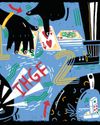
All creatures, from the banana-buzzing fruit fly to the great blue whale, have some form of memory. Elephants remember the locations of distant watering holes. Mice remember how to find their way through laboratory mazes to food. And squirrels, who bury up to 10,000 nuts every year, remember-most of the time where they put them. Crows remember human faces. So, beware: If you're ever mean to a crow, they'll likely remember you.
Of all the memories in the animal kingdom, though, yours is especially impressive.
Each human brain contains about 90 billion neurons-and each of these can form more than a thousand connections with other neurons. Memories are stored in these connections, called synapses. This all adds up, scientists estimate, to more than 60 trillion connections, 2.5 million gigabytes (GB) of memory. (You've got your computer beat-a typical laptop may have eight GB of working memory plus another 256 GB of storage space.) That's right, your memory is huge. If it worked like a computer's hard drive, it would be large enough to store the information from five billion books, 670 million webpages, or 350 years' worth of television shows or films.
Short, Long, and In-Between
Scientists generally divide memory into two major types, short-term and long-term. All information-from the colors of the rainbow to your best friend's telephone number-first enter your memory through a holding pen called short-term memory. Short-term memory is just that, short. It only lasts around 30 seconds, and you can't put much in it. Studies show that short-term memory can only hold about seven pieces of information at a time.
Short-term memory is also easily disrupted. An interruption-say, a dog's bark or a phone's beep-can knock the information in short-term memory right out of your head.
Denne historien er fra September 2023-utgaven av Muse Science Magazine for Kids.
Start din 7-dagers gratis prøveperiode på Magzter GOLD for å få tilgang til tusenvis av utvalgte premiumhistorier og 9000+ magasiner og aviser.
Allerede abonnent ? Logg på
Denne historien er fra September 2023-utgaven av Muse Science Magazine for Kids.
Start din 7-dagers gratis prøveperiode på Magzter GOLD for å få tilgang til tusenvis av utvalgte premiumhistorier og 9000+ magasiner og aviser.
Allerede abonnent? Logg på

HOUSE OF CARDS
TRY THE PERFECT EXPERIMENT—AND THEN REFLECT ON HOW IT WENT.

ACCIDENTALLY Delicious
Have you ever been really hungry, but there wasn't much to eat in your kitchen? Did you throw together a bunch of stuff you had on hand and were pleasantly surprised when it tasted good?

IS YOUR SOCIAL MEDIA FEED TOO PERFECT?
EVERYONE'S LIFE CAN APPEAR PERFECT ON SOCIAL MEDIA. On YouTube, Instagram, Snapchat, and similar apps, people tend to share their happiest, most picturesque moments. They carefully compose any text to get the message just right. They use filters and enhancements to glam up images and videos. The app sorts the posts with the most likes and comments to the top. The end result? All you see of others' lives is the best of the best.

Art ALERT!
THE CASE OF THE MASTERPIECE THAT WASN'T

MARYAM ZARINGHALAM
SCIENCE POLICY FELLOW AND WRITER

Lost Cat Treks More Than 800 Miles to Get Home
Rayne Beau (pronounced RANE-BO, as in \"rainbow\") is a two-year-old Siamese cat.

EASY AS ABC
But in number theory, well, it's complicated.

That Wanaka Tree Gets a Companion
\"THAT WANAKA TREE,\" AS IT'S CALLED, IS A FAMOUS WILLOW TREE THAT GROWS OUT OF LAKE WANAKA ON THE SOUTH ISLAND OF NEW ZEALAND.

Two College Students Devise Smart Glasses That Can ID People
YOU'RE WAITING FOR THE SUBWAY WITH A COUPLE OF YOUR FRIENDS.

Two Comb Jellies Can Fuse Their Bodies Together to Become One
COMB JELLIES ARE GELATIN-LIKE AND MOSTLY SEETHROUGH INVERTEBRATES, OR ANIMALS WITHOUT A BACKBONE, THAT FLOAT IN THE OCEAN NEAR SHORE.